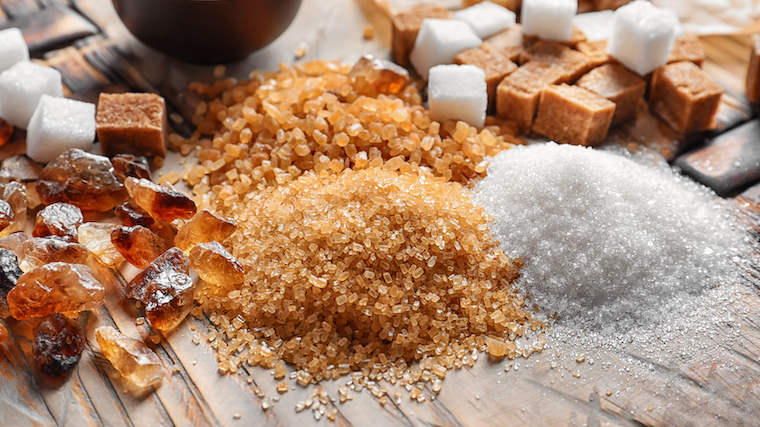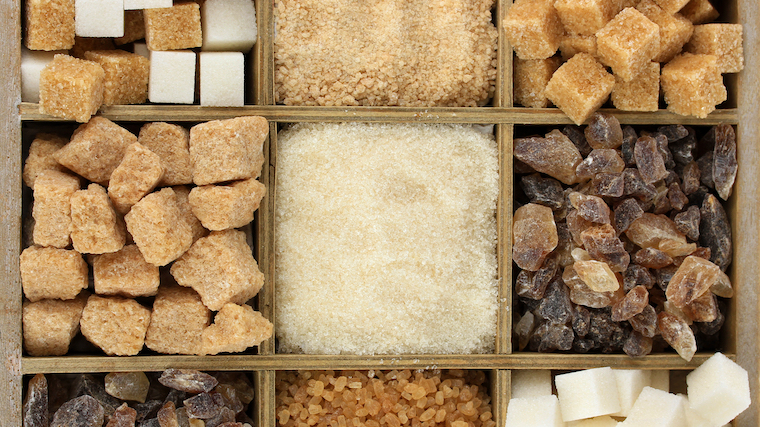Sugar plays a significant role in fueling the global obesity epidemic, as it makes it easy to enter a caloric surplus. However, sugar can play a nuanced and even helpful role in one’s diet when not ingested aimlessly, like from sugary sodas and other empty calories (i.e., calories that offer no nutritional value).
In a video published on Oct. 22, 2023, Jonathan Bennion, co-founder of the Institute of Human Anatomy, delved into the dynamics of sugar in the body and how exercise impacts sugar utilization.
Exercise causes incredible changes within the human body. One…is how exercise affects the body’s ability to process, utilize, and store sugars.
Check out the video below, courtesy of the Institute of Human Anatomy’s YouTube channel:
[Related: The Best Halloween Candy to Eat for Post-Workout Gains, According to an RD]
How Table Sugar Enters Skeletal Muscle
When discussing sugar, most people refer to table sugar. However, for biology and exercise physiology, ‘sugar’ usually refers to simple carbohydrates, which includes monosaccharides (one molecule of sugar) and disaccharide (two molecules of sugar).
Glucose and fructose are monosaccharides, whereas table sugar is a disaccharide called sucrose. A single serving of table sugar comprises multiple molecules of sucrose. Monosaccharides are simple sugars the body can absorb easily. On the flip side, the body must break down disaccharide sucrose into simple sugars before absorbing them from the gastrointestinal tract. (1)
The liver is highly efficient at capturing fructose and another dietary monosaccharide called galactose. It catches fructose or galactose and immediately converts it to glucose, preventing fructose or galactose from circulating throughout the body.

“The end game is glucose,” said Bennion. “No matter what carbohydrate source you ingest, your body will first have to break it down into individual monosaccharides before it can be absorbed.” Furthermore, any monosaccharides that were not already glucose must be converted in the liver. Once the glucose is in the bloodstream, it can be transported to any cell throughout the body.
The Role of Insulin
As glucose enters the bloodstream, blood sugar levels rise. How fast it rises is often measured by the glycemic index (GI). The nutrients from the high glycemic index foods can be absorbed into the bloodstream faster, causing a more significant spike in blood glucose levels. Rising blood glucose levels stimulate the pancreas to release insulin. (2)
How Glycogen is Stored and Used
Once glucose enters a cell, one of two things happens depending on the cell’s energy state: glucose can be immediately utilized for energy or stored as glycogen as body fat for later use. On average, the liver can store 90 to 100 grams of glycogen. Skeletal muscles can hold about 400 grams of glycogen. Regular, consistent exercise and training can increase the glycogen storage capacity of the skeletal muscles. (3)(4)

Resting glycogen levels in a trained individual can be 20 to 30 percent higher than in an untrained individual. Elevated glycogen levels enable sustained higher-intensity performance for extended durations. Furthermore, they allow the body to store more carbs before the sugar is converted and stored as fat. (5)
Effects of Exercise on Skeletal Muscles
Exercise has a powerful insulin-like effect on skeletal muscle fibers. The majority of cells throughout the body require insulin to bring in glucose from the blood. The contraction of muscle fibers during training does not require insulin for its glucose uptake. This is known as insulin-independent glucose uptake. However, a resting skeletal muscle fiber still needs insulin to bring in glucose from the bloodstream. This is known as insulin-dependent glucose uptake.
Even though resting skeletal muscle fibers rely on insulin for glucose uptake, exercise changes how those muscle fibers respond to insulin. Exercise sensitizes muscle fibers to insulin, requiring less insulin to bring in glucose from the blood. (6)

The sensitization to insulin has short and long-term effects. Exercising consistently promotes cells to respond properly to insulin and, therefore, requires less insulin long-term. The body utilizes glucose and the three macronutrients (protein, carbs, and fats) properly.
In the short term, one to two hours after exercise, muscles become sensitive to insulin. Bodybuilders training for hypertrophy tend to capitalize on this ‘anabolic window’ by eating fast-digesting proteins and carbs.
Is Table Sugar Bad?
“Labelling sucrose as completely bad isn’t totally appropriate,” said Bennion. “You really need to consider the context and the frequency of its consumption.”
Consuming sucrose directly after exercise is an effective way of replenishing glycogen stores quickly. It can also help maximize recovery and reduce fatigue for future training sessions. Ingesting sucrose during training sessions that last longer than an hour can prolong peak training performance. (7)
When and How Sucrose Becomes a Problem
Sucrose is considered empty calories — again, meaning it contains no nutritional value. But because of its delectable taste leading to widespread use in various foods, it is easy for someone to consume a lot of sucrose without feeling full. This can lead to overindulgence. Excessive sucrose consumption can cause individuals to exceed their glycogen storage capacity, resulting in body fat buildup.
References
- Kluch M, Socha-Banasiak A, Pacześ K, Borkowska M, Czkwianianc E. The role of disaccharidases in the digestion – diagnosis and significance of their deficiency in children and adults. Pol Merkur Lekarski. 2020 Aug 22;49(286):275-278. PMID: 32827425.
- Ludwig DS, Majzoub JA, Al-Zahrani A, Dallal GE, Blanco I, Roberts SB. High glycemic index foods, overeating, and obesity. Pediatrics. 1999 Mar;103(3):E26. doi: 10.1542/peds.103.3.e26. PMID: 10049982.
- Hearris MA, Hammond KM, Fell JM, Morton JP. Regulation of Muscle Glycogen Metabolism during Exercise: Implications for Endurance Performance and Training Adaptations. Nutrients. 2018 Mar 2;10(3):298. doi: 10.3390/nu10030298. PMID: 29498691; PMCID: PMC5872716.
- Murray B, Rosenbloom C. Fundamentals of glycogen metabolism for coaches and athletes. Nutr Rev. 2018;76(4):243-259. doi:10.1093/nutrit/nuy001
- Vigh-Larsen JF, Ørtenblad N, Spriet LL, Overgaard K, Mohr M. Muscle Glycogen Metabolism and High-Intensity Exercise Performance: A Narrative Review. Sports Med. 2021 Sep;51(9):1855-1874. doi: 10.1007/s40279-021-01475-0. Epub 2021 Apr 26. PMID: 33900579.
- Larsen MR, Steenberg DE, Birk JB, Sjøberg KA, Kiens B, Richter EA, Wojtaszewski JFP. The insulin-sensitizing effect of a single exercise bout is similar in type I and type II human muscle fibres. J Physiol. 2020 Dec;598(24):5687-5699. doi: 10.1113/JP280475. Epub 2020 Oct 1. PMID: 32916040.
- Gonzalez JT, Fuchs CJ, Betts JA, van Loon LJ. Glucose Plus Fructose Ingestion for Post-Exercise Recovery-Greater than the Sum of Its Parts? Nutrients. 2017 Mar 30;9(4):344. doi: 10.3390/nu9040344. PMID: 28358334; PMCID: PMC5409683.
Featured image via Shutterstock/New Africa.